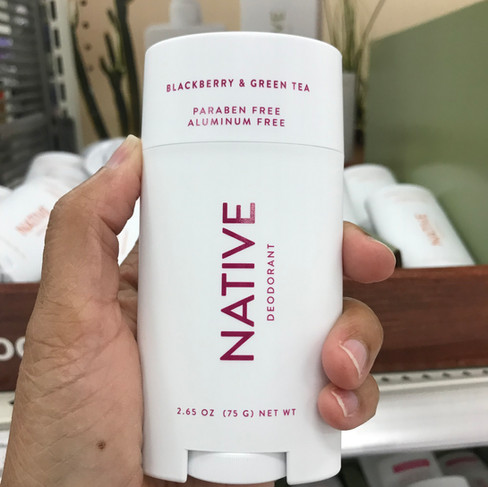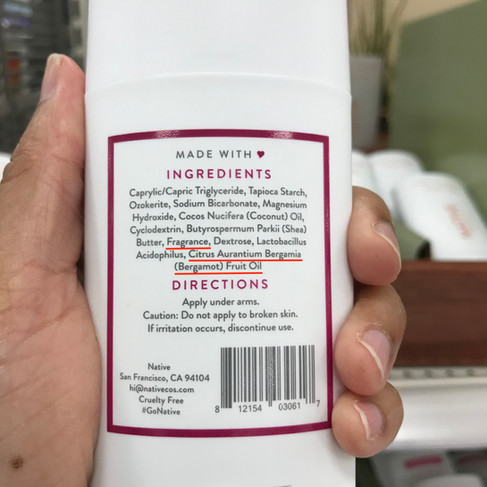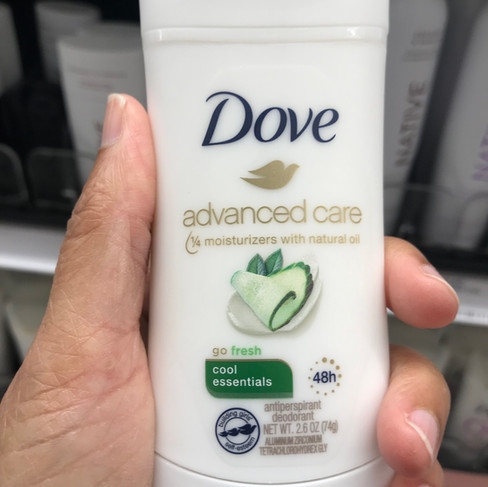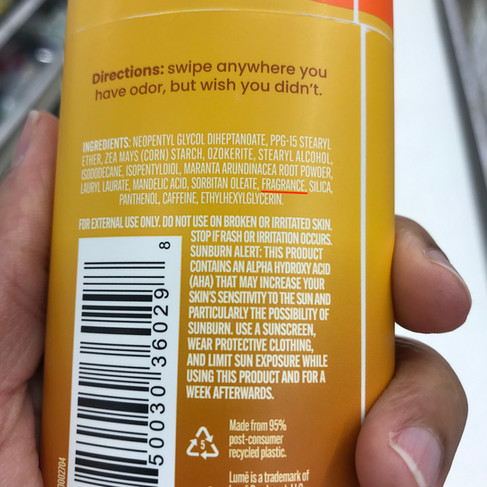Allergy to deodorant is becoming more common, but there are sensitive skin deodorants you can use
- Jenny She, Rajani Katta MD
- Oct 5, 2023
- 9 min read
Updated: Oct 9, 2023
Over the summer, I received a text message from one of my friends. Her daughter had developed a very red and itchy rash in both underarms. She didn't know what had triggered this rash, but she was worried about a deodorant allergy.
Trying to solve the rash, my friend went to the store and purchased a natural deodorant, thinking that it might solve the problem. Unfortunately, it was now two weeks later and the rash was still just as bad.
I wasn’t surprised. As a specialist in allergic reactions of the skin, I have been seeing many, many allergic reactions to deodorants. I’m not sure why that is, but one possibility is the explosion of different fragrances that are used in deodorants.
If you want to learn more about deodorant allergy, keep reading. In this post, I’ll discuss what an allergy to deodorant looks like, along with why you might have a deodorant allergy. I’ll also discuss how long a deodorant rash may last, the treatment for deodorant allergy, and my recommendations for sensitive skin deodorants.
Can deodorant cause rashes on armpits?
How can you tell if you’re allergic to deodorant?
The most common type of deodorant allergy is an allergic reaction called allergic contact dermatitis. This type of allergic reaction produces inflammation of the skin.
The rash is usually red and itchy.
In the early stages, it may just show up as a red rash in any place where the deodorant has been applied.
As the rash progresses, it can start to spread beyond that area.
The rash can also get very dry and flaky.
In very severe cases of allergy, the skin can get red and swollen and sometimes it can even blister.
The rash may be very itchy, or it can be painful or burn.
Even natural deodorants such as brands like Native, Schmidt's, and Tom’s of Maine can contain ingredients like fragrance and oil of bergamot that can trigger allergic skin reactions.
If I’m allergic to deodorant, why doesn’t it burn when I put it on?
One of the most important points to remember about deodorant allergy is that it typically doesn't cause any symptoms at all at first.
In fact, it classically takes anywhere from 2-7 days following the use of the deodorant before the rash even starts.
This type of allergy is known as a delayed allergy, also known as allergic contact dermatitis or delayed type hypersensitivity.
That delay before the rash appears is one of the hallmarks of deodorant allergy.
That delay is also why it can be so hard to figure out what you’re allergic to.
How long does an armpit rash from deodorant last?
Even if you stop using all deodorant today, it can still take up to eight weeks for your skin to recover. Treatment can help reduce this time, but I still warn my patients that even with treatment it can take up to 2 months for the rash to go away.
How do you treat underarm rash from deodorant? Should I stop using deodorant if I have a rash?
In any case of allergic contact dermatitis, the first step in treatment is to stop using the trigger.
In this case, you would stop the suspect deodorant.
Then, you would switch to one of the sensitive skin deodorants listed later in the article (you can jump to the bottom of the article for the list).
Just to emphasize that point: you don’t necessarily have to stop using all deodorants. You just need to switch to a hypoallergenic deodorant.
This will help most people with a deodorant allergy, although remember that it can take up to 8 weeks for your skin to improve.
Depending on the severity of the rash, your dermatologist may recommend an over-the-counter anti-inflammatory cream or ointment. In some cases, especially if the rash is more severe, your dermatologist may prescribe a prescription-strength medicated anti-inflammatory cream or ointment.
Why am I suddenly allergic to my deodorant?
Sometimes it can be tricky to figure out why an individual develops an allergic reaction of the skin.
First, let me clear up a few misconceptions:
You can develop an allergy to deodorant at any age, even if you’ve never had skin allergies before.
You can also develop an allergy to a product that you’ve been using for years, even if the formulation of the product hasn’t changed.
Although in some cases we don’t know why you would suddenly develop a deodorant allergy, here are some possible reasons:
One potential reason for the development of a new skin allergy is that the skin barrier has had a breakdown. If your skin barrier is impaired, that can make allergic skin reactions more likely to develop.
In the case of underarm skin, one of the top factors is shaving the underarms and then applying deodorant right afterward.
When you shave, you create tiny cracks in the skin. If you apply deodorant afterward, the ingredients in that deodorant can penetrate through to the deeper layers of the skin, where the cells of the immune system are stationed. Sometimes your immune system will “see” these ingredients, and will consider them a threat. When that happens, it sets off a chain reaction of inflammation that ultimately produces the rash that you see.
Another reason why you may have developed a deodorant allergy is due to the ingredients in the deodorant.
Many deodorants are now using interesting combinations of fragrance additives. Some of these fragrance additives, such as the oil of bergamot, are more likely to trigger allergic reactions in general.
What ingredients in deodorants cause allergic reactions?
What ingredients in deodorants cause irritation?
There are lots of different ingredients that may be used in deodorants. Some may cause irritation, while others may cause allergic reactions. Whether you’re experiencing irritation or allergy to an ingredient, it’s important to remember that the rash may look exactly the same: red, itchy, and sometimes raw or blistered.
The main active ingredient in deodorants, aluminum hexahydrate, may cause irritation when it’s used at high concentrations. Sometimes prescription or extra-strength deodorants use these high concentrations.
Deodorant allergy, on the other hand, is usually from other ingredients. The top two triggers of deodorant allergy are:
Fragrance
Propylene glycol
This Dove brand deodorant contains “fragrance“ in the ingredient list. Fragrance additives are one of the most common ingredients in deodorants to trigger allergic rashes. Although the ingredient list just uses the one word "fragrance", studies have found that this single word may indicate up to 40 different fragrance additives.
Far and away, the most common trigger that I see for deodorant allergy is fragrance additives. If you look at the ingredient list on most deodorants, they may just list one word related to fragrance: “fragrance” or “parfum.”
Unfortunately, that one word should really be “secret mixture of fragrance additives.” As this blog post details, that one word– “fragrance”– can actually indicate the presence of 40 or more different fragrance additives. You may become allergic to one or more of those individual fragrance additives included in that fragrance mix.
What are some names for fragrance additives in deodorants?
You should definitely avoid any products that list “fragrance” or “parfum” in the ingredient list. Beyond that, there are other types of fragrance additives that may be listed on the label, even though many people may not recognize them as fragrance additives. Fragrance additives include:
Fragrance
Parfum
Linalool
Limonene
Oil of bergamot
Other essential oils
Citronellal
Hydroxycitronellal
And many others
How can you tell if you’re allergic to deodorant?
Many of my patients already suspect a deodorant allergy when they come to me. One way to test for deodorant allergy is to stop using your current deodorant and instead use one of the hypoallergenic deodorants listed in this post. Remember, though, that it can take up to 8 weeks for the rash to improve, even if you stop using the original deodorant completely.
The most definitive way to test for a deodorant allergy is a type of testing called patch testing. In this test, small amounts of different substances, called allergens, are placed on the back for 48 hours. You return to the doctor’s office at 72 or 96 hours, and they will read the tests and let you know what substances you are allergic to. Patch testing can confirm an allergy to deodorant ingredients.
If I am allergic to deodorants, can I use natural deodorants instead? Can I use fragrance-free deodorants?
Natural deodorants MAY OR MAY NOT BE a good option.
We have a saying in dermatology. “Poison ivy is all natural.” Although they sound like they might be better/safer, natural fragrance additives like oil of bergamot are known for being common triggers of allergic reactions.
Products labeled fragrance-free MAY OR MAY NOT BE a good option. Legally, products labeled fragrance-free can still contain fragrance additives. That’s because there’s a loophole in the labeling laws in the United States that permits this surprising exception. For more on these loopholes and others, please see this article in Today where I explain some of the surprising facts about labeling laws.
For truly fragrance-free deodorants, please see the list at the end of this post.
Can you be allergic to natural deodorant?
As I have explained to many patients, yes! You can be allergic to natural deodorant. A common follow-up question from my patients is “why am I having a reaction to natural deodorant?”
That’s a great question, and it often comes down to the types of ingredients that are used in natural deodorants. Specifically, many natural deodorants make use of natural fragrance additives and essential oils. These are common triggers of allergic skin reactions. Although you would think that natural products would be better for your skin, these natural ingredients can be just as worrisome, or even more so, when it comes to causing allergic skin reactions.
As I like to say, (and I’ll repeat it here) “poison ivy is all-natural.” Similarly, ingredients like oil of bergamot are well-known for causing allergic skin reactions. Despite that, these substances are still found in some deodorants.
What deodorant is best for sensitive skin?
What deodorant can I use if I have a deodorant allergy?
For a list of truly fragrance-free deodorants that would be appropriate for most people with sensitive skin, please see the list below. This is only a partial list; there are other fragrance-free deodorants available. These products would be appropriate for many people with sensitive skin, although not all, because sometimes the skin is so inflamed that any deodorant will irritate it further.
Although they may not work for everybody, these products are a potential choice for many people with deodorant allergies.
HYPOALLERGENIC DEODORANTS/ ANTIPERSPIRANTS:
Almay roll-on deodorant (roll-on only)
Crystal Body Deodorant Stick (fragrance-free)
Crystal Roll-On Body Deodorant (fragrance-free)
Vanicream Deodorant for Sensitive Skin (Aluminum Free)
Vanicream Antiperspirant/Deodorant
What is a good fragrance-free deodorant? What types of deodorant can I use if I’m allergic to fragrance?
Please see the list above for some truly fragrance-free deodorants.
Can deodorants work if they don’t contain any fragrance?
I’m not sure when heavily-scented deodorant became so popular, but there is no need to add fragrance to a deodorant. Your underarms don’t need to smell like mango. From a skin health standpoint, I always recommend deodorants that are truly fragrance-free. The added fragrances in a deodorant do not make them work any better. These fragrance additives don’t function to remove odor; they are only there to add additional scent.
What are some deodorant brands that might cause deodorant allergy?
Whether it's large brands or smaller boutique brands, those added fragrances can be an issue. It doesn’t matter whether a fragrance is all-natural or synthetic: both types can trigger allergic contact dermatitis. In fact, some types of natural fragrances, such as orange oil, citronella oil, or ylang-ylang oil, are known for being more likely to trigger allergic skin reactions.
Brands that may cause deodorant allergy (because of their fragrance additives) include:
Old Spice
Lume
Secret
Dove
Degree
Major brands such as Old Spice, Secret, Dove, and Lume may contain fragrance additives and trigger allergic armpit rashes. Smaller boutique brands and natural brands can also trigger allergic reactions.
Even natural brands or smaller boutique brands can cause an issue. That’s because they often contain natural fragrance additives.
Tom's of Maine
Schmidt's
Kopari
Native
Necessaire
Salt & Stone
Dr. Squatch
Kosas
evolvetogether
CRYSTAL
Ursa Major
Oars and Alps
Are there other products that might cause a rash in my underarms? Are there other reasons I might have an armpit rash?
Deodorant allergy is only one potential cause of rashes in the underarm area. Some other potential causes include:
Skin infections
Inflammatory skin conditions
An allergic reaction to shower gel or body wash
An allergic reaction to clothing in chemicals, such as formaldehyde finishes or textile dyes
There are many other potential causes of armpit rashes
If your rash is not getting better, you need to see your dermatologist for an accurate diagnosis. For more on other causes of allergic skin reactions in the underarm area or armpits, please see this handout.
The Bottom Line
I don’t recommend any fragrances (natural or synthetic) in the underarm area, especially if you have a history of sensitive skin and if you shave. It can be tricky to read an ingredient list and know if your deodorant contains fragrance. Definitely avoid any that list “fragrance” or “parfum” and see the list above for a partial list of other names for fragrance additives. The fragrance-free deodorants below would be an option for many people with sensitive skin.
HYPOALLERGENIC DEODORANTS/ ANTIPERSPIRANTS:
Almay roll-on deodorant (roll-on only)
Crystal Body Deodorant Stick (fragrance-free)
Crystal Roll-On Body Deodorant (fragrance-free)
Vanicream Deodorant for Sensitive Skin (Aluminum Free)
Vanicream Antiperspirant/Deodorant













